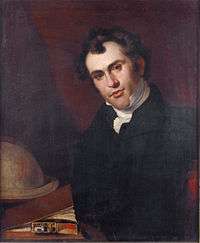John Arrowsmith (cartographer)

John Arrowsmith (1790–1873) was an English geographer (mapmaker) and member of the Arrowsmith family of geographers. He was born at Winston, County Durham.
In 1810 he joined his uncle Aaron Arrowsmith in his mapmaking business in London. In 1821, they published a map of North America using a combination of a maps obtained from the Hudson's Bay Company and Aaron's own previous work. After his uncle died in 1823, the business was carried on by his sons Aaron and Samuel Arrowsmith until 1839 when John Arrowsmith took over the business.[1] In 1834 John published his London Atlas, which were the best set of such maps then in existence. He followed the atlas with a long series of elaborate and carefully executed maps, those of Australia, America, Africa and India being especially valuable. In 1863 he received the gold medal of the Royal Geographical Society, of which body he was one of the founders.
His maps were very numerous, and their neatness and finished style gained John a very extensive reputation. Arrowsmith was also a most industrious collector of materials.
Mount Arrowsmith, situated east of Port Alberni on Vancouver Island, British Columbia, is named for John Arrowsmith and his uncle Aaron Arrowsmith.[2] The Arrowsmith River in Western Australia was named by Sir George Grey after Arrowsmith, who later produced the maps for the published journals of Grey's two Western Australian expeditions.[3]
Maps of John Arrowsmith
Listed in order of publication date | Reference: David Rumsey Historical Map Collection[4]
- 1832: England
- 1832: Europe
- 1832: Ireland
- 1832: Sweden & Norway
- 1832: Belgium & Holland
- 1832: Denmark (with Iceland)
- 1832: Orbis Veteribus Notus (Europe/Asia/Africa)
- 1832: Western Germany
- 1832: Austrian Empire
- 1832: Russia & Poland
- 1832: Switzerland & the Passes of the Alps
- 1832: South Italy
- 1832: Greece & the Ionian Islands
- 1832: Spain & Portugal
- 1834: North Italy & the Passes of the Alps
- 1834: France
- 1834: The Inland Railroads, Navigation, Geology & Minerals of England
- 1834: Scotland
- 1834: Prussia & Poland
- 1838: New Zealand
- 1842: British Guiana
- 1842: Australia, Eastern Portion
- 1843: Texas
- 1844: Switzerland
- 1844: Europe
- 1844: England
- 1844: Ireland
- 1844: Africa
- 1844: Asia
- 1844: China
- 1844: America
- 1844: Brazil
- 1846: British North America
- 1849: Vancouver Island and the Adjacent Coasts
- 1854: British North America
- 1848: Southern Tip of Vancouver Island and Oregon Territory
- 1850: Southern Tip of Vancouver Island
- 1850: Asia Trade Routes
- 1856: Vancouver Island
- 1857: South Africa - Showing the Routes of the Rev'd Dr. Livingstone between the years 1849 & 1857
- 1865: South Eastern Africa - Map of the River Shire, the Lakes Nyassa & Shirwa, the Lower Courses of the Rivers Zambesi, & Rovuma
- 1880: Africa
- 1901: Map of the Ionian Islands & Malta
References
- ↑ Hayes, Derek (1999), Historical Atlas of British Columbia and the Pacific Northwest, Vancouver: Cavendish Books, p. 58, ISBN 1-55289-900-4
- ↑ Integrated Land Management Bureau, Government of British Columbia. Geographic place names.
- ↑ Grey, George (1841). Journals of two expeditions of discovery in North-West and Western Australia, during the years 1837, 38, and 39, describing many newly discovered, important, and fertile districts, with observations on the moral and physical condition of the aboriginal inhabitants, etc. etc. 2. London: T. and W. Boone. p. 56. Retrieved 2012-03-17.
- ↑ Luna Imaging, David Rumsey Historical Map Collection, search terms (exact phrase) "Arrowsmith, John"
| Wikimedia Commons has media related to John Arrowsmith. |
| Wikisource has the text of the 1885–1900 Dictionary of National Biography's article about John Arrowsmith. |